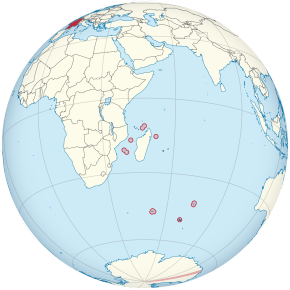
Back Franse Suidelike en Antarktiese Gebiede Afrikaans Territorios Australs Franceses AN أراض فرنسية جنوبية وأنتارتيكية Arabic Tierres Australes y Antártiques Franceses AST Fransanın Cənub və Antarktika əraziləri Azerbaijani فرانسه گونئی و قوطب تورپاقلاری AZB Францияның Көньяҡ һәм Арктик биләмәләре Bashkir Французскія Паўднёвыя і Антарктычныя тэрыторыі Byelorussian Францускія Паўднёвыя і Антарктычныя тэрыторыі BE-X-OLD Френски южни и антарктически територии Bulgarian
This article needs additional citations for verification. (March 2021) |
French Southern and Antarctic Lands Terres australes et antarctiques françaises (French) | |
|---|---|
|
| |
| Motto: | |
| Anthem: La Marseillaise ("The Marseillaise") | |
 Location of French Southern and Antarctic Lands (circled in red) in the Indian Ocean (light blue) | |
| Sovereign state | |
| Territorial status | 6 August 1955[1] |
| Capital | Saint Pierre, Réunion (headquarters, not geographically assigned) 43°00′S 67°00′E / 43.000°S 67.000°E[2] |
| Largest settlement | Port-aux-Français |
| Official languages | French |
| Government | |
| Emmanuel Macron | |
• Prefect, Administrator Superior | Florence Jeanblanc-Risler |
• Secretary General | Thierry Dousset[3] |
| Legislature | Advisory Council of the TAAF |
| Area | |
• Total | 439,666.4 km2 (169,756.1 sq mi) |
| Population | |
• Estimate | Officially 400~800 permanent scientists and military personnel[4] No known permanent population[5] |
| Currency | Euro (€) (EUR) |
| Time zone | |
| Driving side | right |
| ISO 3166 code | |
| Internet TLD | .tf |
| Website | taaf |
The French Southern and Antarctic Lands[6] (French: Terres australes et antarctiques françaises, TAAF) is an overseas territory (French: Territoire d'outre-mer or TOM) of France. It consists of:
- Adélie Land (Terre Adélie), the French claim on the continent of Antarctica.
- Crozet Islands (Îles Crozet), a group in the southern Indian Ocean, south of Madagascar.
- Kerguelen Islands (Archipel des Kerguelen), a group of volcanic islands in the southern Indian Ocean, southeast of Africa.
- Saint Paul and Amsterdam Islands (Îles Saint Paul et Amsterdam), a group to the north of the Kerguelen Islands.
- Scattered Islands (Îles Éparses), a dispersed group of islands around the coast of Madagascar.
The territory is sometimes referred to as the French Southern Lands (French: Terres australes françaises) or the French Southern Territories,[7] usually to emphasize non-recognition of French sovereignty over Adélie Land as part of the Antarctic Treaty System.[5]
The entire territory has no known permanently settled inhabitants. Approximately 150 (in the winter) to 310 (in the summer) people are usually present in the French Southern and Antarctic Lands at any time, but they are mainly made up of military personnel, officials, scientific researchers and support staff.[8]
On 5 July 2019, the Crozet Islands, the Kerguelen Islands, and the Saint Paul and Amsterdam Islands were inscribed as a UNESCO World Heritage Site as the "French Austral Lands and Seas" because of their pristine wilderness, biodiversity, and enormous bird colonies.[9]
- ^ Government of the French Republic (6 August 1955). "Loi n° 55-1052 du 6 août 1955 conférant l'autonomie administrative et financière aux Terres australes et antarctiques françaises". legifrance.gouv.fr (in French). Retrieved 19 October 2019.
- ^ French Southern and Antarctic Lands in Geonames.org (cc-by)
- ^ Government of the French Republic (6 March 2020). "Arrêté du 6 mars 2020 portant nomination du secrétaire général des Terres australes et antarctiques françaises". legifrance.gouv.fr (in French). Retrieved 6 April 2020.
- ^ TAAF Collectivity. "Présentation des territoires". taaf.fr (in French). Retrieved 19 October 2019.
- ^ a b "Antarctica :: French Southern and Antarctic Lands". CIA.gov/Library/Publications/The-World-Factbook. CIA. 20 May 2020. Retrieved 10 October 2018.
- ^ "List of countries, territories and currencies". Interinstitutional style guide. Publications Office. 12 June 2008. Retrieved 29 June 2008.
- ^ "French Southern Territories". ISO.org. ISO. 26 November 2018. Retrieved 12 July 2020.
- ^ "The TAAF do not have any permanent population." "The French Southern and Antarctic Lands". French Southern and Antarctic Lands administration. Archived from the original on 26 May 2017. Retrieved 31 May 2016.
- ^ "Five sites inscribed on UNESCO's World Heritage List". UNESCO. 5 July 2019.

